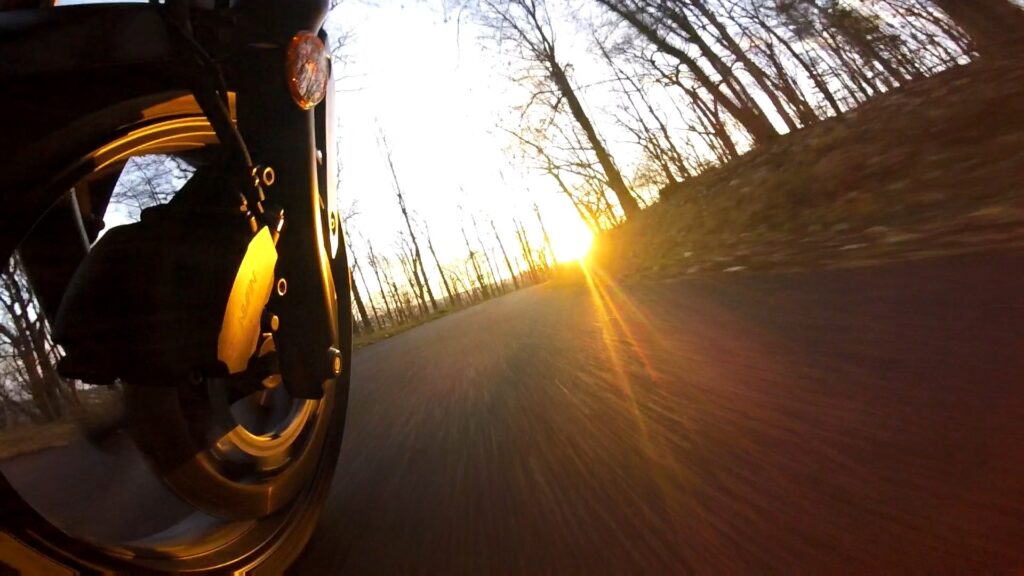
It’s been a hot minute since I’ve been on my motorcycle, between a combination of busy schedules and sketchy weather. Since I’m still so new, and my bike is such a beast, I’ve been wanting to make sure that I’m only riding in good conditions and when I’m feeling up to it. Turns out, that was a wise decision, and it’s going to lead to some changes as we head into winter. Some of the lessons I’ve learned are, I think, applicable to any new and tasking endeavor you might pick up, whether it’s riding a motorcycle like me, or learning a different new sport or skill, like shooting a gun or driving a car.
Being a beginner with a pursuit that requires combining the physical and mental is hard. It’s challenging to remember what to do with the left hand (let the clutch out slowly!) and the right (open the throttle by rolling the grip toward you, but not too much!), the right foot (come off the brake and get on the peg as the bike starts going, not too early, not too late!), and the left foot (lift off the ground when the bike starts balancing itself, then get ready to shift!), all while trying to pay attention to the road conditions, following my friend who was leading our ride, and all of the vehicles around me. Those of you who are experienced riders may come by to tell me how so much of that will become subconscious and automatic, allowing me to devote more brain cycles to the things that absolutely require conscious thought, but that will require repetition and familiarity. Going over basic skills regularly, but also stretching out of your comfort zone, are necessary in order to get better and more comfortable, whether on a motorcycle or, say, in the kitchen.
One of the reasons the best way to get better is to do a thing more is because it’s difficult to otherwise practice all of the conditions that can occur. For example, yesterday we got stuck in traffic on an uphill, where I learned just how tough it was to keep my Bobber upright and moving forward slowly, especially when I can only get one foot flat on the ground. The most convenient place to work on that skill, as anxiety-provoking as it was, was on that street at that moment. Taking a break showed me that while some of it was easier for me to accomplish than when I first started and than I expected after a long layoff, some of it was nearly ground zero again. Starting slowly, with easier conditions, is an important part of making those challenges surmountable as a newbie. If the earlier parts of my ride hadn’t included refreshers on starting from a stop, moving slowly forward on flat surfaces, and simply launching to regular speeds from a stoplight at gentle hills, that creeping traffic jam might have been impossible for me to handle. That’s the same reason I’m sticking with daylight and dry roads for now, and will start with parking lots and easy routes when I start out again after winter, even though it’s tempting to think that my shiny license means I know enough to ride whatever I want, whenever I want. And it’s the same reason why a few lessons and practice sessions with a firearm combined with a concealed carry permit doesn’t necessarily mean you are ready to carry a gun and solve violent problems with it right away.
Our tour took us seventy miles and three hours around the region, including a beautiful tour through Valley Forge National Park (this pic is from an earlier trip our ride leader took there). It was beautiful; it was fun; it was just a little bit too much. I’m in good shape and even with the tiny shocks on my Bobber and my clutch lever still being slightly too far out of reach, the physical exertion of riding for that long wasn’t overly taxing. I was even able to pick up my own bike after I dropped it (oops; it’s okay, we’re okay, these things happen). But my brain? It got exhausted. With so much to think about, and how mentally immersive the trip was between the skills I was exercising and the scenery I was seeing, my thoughts were racing at every moment. I needed full concentration to operate the motorcycle, stay safe on the roads, and enjoy glimpses of the views in between. It’s easy to forget how much that can affect a person’s ability to perform physical skills. Mentally tired is still tired, and that’s when mistakes pop up. Challenges that I was able to manage earlier in the afternoon became mentally overwhelming towards the end, and that’s when I forgot how or forgot I was able to do more difficult things like tight turns from a stop. Next time, I’m not going to come back from a break and think I’m going to be able to do everything I could before, for hours on end. A shorter ride on familiar roads would be much smarter.
And in the meantime, I think I’m going to succumb to the disease and buy myself another motorcycle, one that retains a lot of the qualities of my beloved Triumph while being easier to get in and out of my garage, require a bit less fighting to maneuver, and be less scary if I lose control or drop it. After all, nobody says you have to learn on hard mode. Even though I love my bike and it’s within my ability to ride, I would get more, and more comfortable, riding time on something a little easier to work with. So, much like swimming in a pool as part of preparing for an open water race, I’m going to get me an easy mode option to polish my skills. What it will be? You’ll have to stick around to find out.




